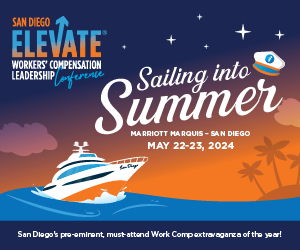WCC's Work Comp World
Thursday, July 29, 2021
GEORGE THE BARTENDER'S DISPATCHES FROM OFFLINE HAPPY HOUR – DIMINISHED EA
- 27560 views
- - 0 shares
"What can I get you?" George the Bartender was busier than ever keeping the drinks flowing for the 4th of July weekend celebration going on at the Lobby Bar, with the bar fully decked out in red, white and blue decorations for the festivities. Life in California was finally getting back to normal after many months of COVID-19 restrictions. If no one was able to celebrate last summer, it looked like everyone decided to go all out with the celebrations this year, and the Lobby Bar was teeming with people.
Bob Falfa, an applicant attorney, was clearly enjoying his martini on the rocks. He began to explain that although it had been a rough year trying to manage COVID-19 and working in the office sporadically, he was really pleased that his client's case went on the record today and he anticipated a great attorney fee out of this 2018 date of injury claim. He was counting the days until the decision.
Bob explained, "I'm going to prove a 50% loss in future earning capacity based upon a Vocational Expert report which will rebut the Permanent Disability Rating Schedule (PDRS) in my case. I could really use a favorable decision like this after the year I've had."
He offered to buy me a drink and handed me his law firm t-shirt bearing his firm's name, Falfa Fall & Accident Attorney, LLC. I declined as George already had my Manhattan ready and I really didn't need another t-shirt.
I toasted, "Here's to California opening up again! Drink up my friend, as I think the days of Vocational Expert Reports being used to rebut the PDRS on new injuries are numbered." Bob immediately slammed down his drink, spilling most of it on the bar. He looked surprised as he asked, "What do you mean?!"
I explained that for injuries after January1, 2013, Labor Code §4660.1(a) states:
In determining the percentages of permanent partial or permanent total disability, account shall be taken of the nature of the physical injury or disfigurement, the occupation of the injured employee, and his or her age at the time of injury.
I pointed out to Bob how this section contrasts with Labor Code §4660(a) regarding injuries before January 1, 2013, which states:
(a)?In determining the percentages of permanent disability, account shall be taken of the nature of the physical injury or disfigurement, the occupation of the injured employee, and his or her age at the time of the injury, consideration being given to an employee's diminished future earning capacity. (Emphasis added)
I told Bob to note that the last phrase of the section used to reflect a "diminished earning capacity" criteria, which was removed from the statute for injuries after January 1, 2013 as part of California Senate Bill 863 (SB863), which was signed into law on September 19, 2012.
I pulled out a copy of the legislative history from the Senate Committee on Industrial Relations in preparation for an August 31, 2012 hearing and handed it to Bob. I told him that on page five, under Permanent Disability heading, number five stated:
Limits the definition of permanent disability to include only a consideration of how occupation affects the overall classification of employment of the injured worker, rather than the individual injured worker's ability to compete in the open labor market or reduction of future earnings.
Although we are not yet there in present panel decisions, the impression you could take from this section was that there was a clear discussion of diminished earning capacity in developing the legislation of §4660.1(a) and it clearly was removed as identified criteria for cases after January 1, 2013, if you read the text of the law.
Taking the legislative history and case law into account, I explained to Bob that Dahl, a post January 1, 2013 SB863 decision, prohibits vocational experts from offering a diminished future earnings capacity rating as an alternative to a permanent disability rating.
Bob then argued that the reason he feels so strongly about his case was that Ogilvie III's third method to rebut a schedule applies because he could rebut the RAND Institute study that was used to develop the current PDRS. He explained that the RAND Institute study was formulated to address a single body part impairment and earning capacity post injury. He went on to say that his case was distinguished from the facts in Dahl, as his client has more than one body part at issue.
I told Bob that his argument was recently used in the panel decision Arturo Diaz v. E&F Demolition (ADJ 11432893), published on April 9, 2021, and the issue lies in the strength of the evidence rebutting the PDRS.
In Diaz the applicant, a laborer for E&F Demolition, had injured his right foot and toes causing a fracture to the second, third and fourth toes, resulting in surgery that included amputation of the second toe. The AME provided a whole person impairment (WPI) rating based on AMA Guides to the Evaluation of Permanent Impairment, (Fifth Edition), aka the Guides, based upon analogy to the thigh and calf atrophy chapter according to Guzman III. The primary treating physician (PTP) also provided his evaluation of the WPI, however, it was based upon nerve damage, amputation with an add-on for pain.
I explained to Bob that in Diaz they also obtained a vocational evaluation report indicating the applicant could rebut the scheduled rating of his disability using the third method provided in Ogilvie III. The vocational expert argued that the applicant experienced injuries to three separate toes, which they considered separate parts of the body and therefore were outside of the RAND study underlying the Guides.
The vocational report indicated that the applicant could no longer work in construction but was amenable to vocational rehabilitation through training and direct placement to obtain new job skills. The vocational expert determined that given this particular injury the applicant was entitled to 50.1% diminished future earning capacity based upon the difference between his pre-injury and post-injury capacity.
The Workers' Compensation Judge (WCJ) in Diaz relied on the 50.1% diminished future earning capacity calculation when issuing their Findings, Orders and Award. The defendants filed a petition for reconsideration, which was granted. The Workers' Compensation Appeals Board (Appeals Board) in their decision overturned the diminished future earning capacity calculation, holding:
The primary method for rebutting the schedule rating is based upon a determination that the injured worker is "not amenable to rehabilitation and, for that reason, the employee's diminished future earning capacity is greater than reflected in the scheduled rating." The employee's diminished future earnings must be directly attributable to the employee's work-related injury and not due to nonindustrial factors such as general economic conditions, illiteracy, proficiency in speaking English, or an employee's lack of education. (Ogilvie, 197 Cal.App.4th at pp. 1274–1275, 1277).
The Appeals Board also quoted Dahl, indicating:
The first step in any LeBoeuf analysis is to determine whether a work-related injury precludes the claimant from taking advantage of vocational rehabilitation and participating in the labor force." (Dahl, 240 Cal.App.4th 746, 758.)
The Appeals Board decided in Diaz that the vocational evaluation report did not establish that the severity or nature of the injury was not captured within the sampling of disabled workers used to compute the adjustment factor in the RAND study. They found the facts of the injury to the right foot, toes and amputation of the second toe alone did not establish that the scheduled rating failed to account for the severity of applicant's injury.
My dissertation and historical analysis completed, Bob looked thoroughly disillusioned and said, "George, I'll take another, and make it a double!" As the 4th of July fireworks erupted over Long Beach, I wished Bob and George a great Independence Day and made one last toast with them, "To George! May his capacity never diminish in serving our drinks!"
DISCLAIMER:
All characters from my online happy hour are fictional and the storyline is simply a product of my lively imagination.
As I cautioned Bob above, it may be a bit early to celebrate a win on diminished earning capacity on a post January 1, 2013 date of injury. This is an area of law that is moving with panel decisions, like Diaz, pointing to a future where disproving the PDRS is becoming more restrictive as intended by the SB863 legislature, and as options expand for the WCAB to account for applicants' whole person impairment.
Diaz lacks the designation "significant panel decision," however, the WCAB may consider panel decisions to the extent that it finds their reasoning persuasive, as laid out in its en banc decision Guitron v. Santa Fe Extruders (2011) 76 Cal. Comp. Cases 228, 242, fn. 7.
Joe Truce, formerly a managing shareholder at our firm and creator of George the Bartender, would draw our attention to California Evidence Code §452(d), which provides that judicial notice may be taken of "Records of (1) any court of this state or (2) any court of record of the United States or of any state of the United States."
We continue to venture out into the world when we can, where doubles can now be prepared by the professionals! Cheers friends, and keep washing your hands.
-Mark Thomas
Mark Thomas has been working at Kegel, Tobin & Truce in 2007 and has been a partner for over 9 years practicing law. He primarily handles workers' compensation defense before the Workers' Compensation Appeals Board on behalf of clients such as self-insured employers, public entities, and insurance carriers. He worked previously for Hanna, Brophy, MacLean, McAleer & Jenson LLP , Los Angeles Office and joined thereafter working as a paralegal for applicant's law firm Lyle Blane. He graduated from Loyola Law School with an internship at Lambda Legal. Prior to practicing law, Mark worked 10 years for the Department of the Navy including as a Labor and Employment Relations specialist negotiating labor agreements and representing the Navy at employment hearings. He is a singer and trumpet player who has performed at the Royal Albert Hall in London, the Disney Hall in Los Angeles and toured the Baltic states with the Ventura Master Chorale.
Advertisements
Now Trending
- Workers' Compensation News
-
Calif. DWC
Launches Portal for QME…
Posted on Apr 24, 2024Dr. Ron Perelman says: “The problem is that most QMEs are older docs. Many are semiretired.…”
-
Calif. DWC Updates
Time-of-Hire…
Posted on Apr 23, 2024
-
Calif. WCIRB
Approves Recommendation for 0.9%
Rate…
Posted on Apr 18, 2024
-
Calif. Committee
Passes Bill to Expand 4850…
Posted on Apr 22, 2024
-
Calif. Committee
Passes Bill to Revise Poster…
Posted on Apr 19, 2024
-
Calif.
Appropriations Committee Places TD
Bills on Suspense…
Posted on Apr 24, 2024
-
Calif. Cal/OSHA
Cites Construction Company $371,100
for Fatal Trench…
Posted on Apr 22, 2024
-
Ore. Worker Can
Request Examination if Carrier
Supports Claim Denial With IME…
Posted on Apr 22, 2024
-
Minn. Supreme
Court Upholds Award to Social
Worker for…
Posted on Apr 19, 2024
-
Ark. Worker Not
Entitled to Additional Benefits
After Date of…
Posted on Apr 22, 2024
Jobs
Upcoming Events
May 5-8, 2024
Risk World
Amplify Your Impact There’s no limit to what you can achieve when you join the global risk managem …
May 13-15, 2024
NCCI's Annual Insights Symposi
Join us May 13–15, 2024, for NCCI's Annual Insights Symposium (AIS) 2024, the industry’s premier e …
May 13-14, 2024
CSIA Announces the 2024 Annual
The Board of Managers is excited to announce that the CSIA 2024 Annual Meeting and Educational Con …
Social Media Links
c/o Business Insurance Holdings, Inc.
Greenwich, CT 06836




